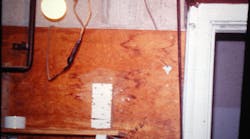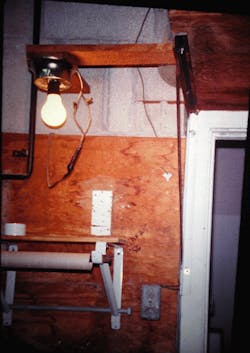How well do you know the Code? Think you can spot violations the original installer either ignored or couldn't identify? Here's your chance to moonlight as an electrical inspector and second-guess someone else's work from the safety of your living room or office. It's your turn to identify the violation.
Hint: Bad wiring choices
Find the Answer
A 2-wire flexible cord was used to wire the switch and the light shown in this Photo. First, this is a violation of Sec. 400.8(1), which prohibits flexible cords and cables from being used as a substitute for the fixed wiring of a structure. In addition, Sec. 400.10 requires flexible cords to be connected to devices or fittings so as not to transmit tension to joints or terminals. The cord dangling by the wire connectors at the light fixture is certainly putting strain on those connections.
Because there is no equipment grounding conductor present, the switch box and the light fixture are not grounded or bonded to the electrical system. This creates a real shock hazard. For this installation, Sec. 410.42 requires the exposed metal parts of the light fixture to be connected to an equipment grounding conductor. Section 314.4 requires the metal switch box to be grounded and bonded in accordance with several provisions of Art. 250. Sections 250.4(A)(2) and (3) require the normally non-current-carrying metal parts of the light fixture to be grounded and bonded to the electrical system. One other dangerous condition to note, which is not visible in the photo, is the slop sink that is directly below the light fixture. Talk about a real shock hazard when your hands are wet!





